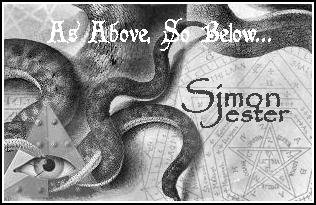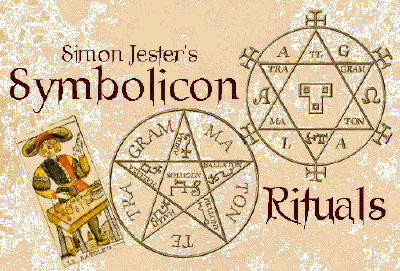Learning the Lesser Hexagram Rituals
Part Iby Simon Jester
How to form Elemental Hexagrams
The Hexagram Rituals used by magicians when working with Planetary/ Sephirothic Forces are much more complex than the Pentagram Rituals, which operate solely on the Elemental Plane. Learning to perform the Hexagram Rituals, in both their Lesser and Greater forms, requires patience and practice but will take your magical work to a much higher level.
The Lesser Banishing/Invoking Ritual of the Hexagram employs a set of four symbols sometimes referred to as the Elemental Hexagrams. These are drawn in the same four quarters in which Pentagrams are drawn (East, South, West and North) but the assignments of elements to these directions in the Lesser Hexagram rituals follow astrological considerations, and therefore differ from the directional assignments used in the Pentagram rituals. In truth, the Lesser Hexagram Rituals are transitional in nature and, when performing them, you are placing yourself in a magical zone where both Elemental and Astrological forces may be tapped simultaneously.
An Elemental Hexagram is drawn in the air, just like a Pentagram, using the Knife or Sword for banishing and the Wand for invoking. (As always, if you lack these tools, or happen to be somewhere without them, you may use the first two fingers of your right hand to cast the Hexagrams.) Again, just as with Pentagrams, you visualize the Elemental Hexagrams forming in lines of bright light and floating in the air at a point directly in front of you.
A single Elemental Hexagram is formed by using two triangles, and each point of a triangle is assigned to one of the traditional celestial spheres as in the following diagrams:
Drawing the four Elemental Hexagrams in the ritually proper fashion is somewhat complicated, and you have to begin the learning process by thoroughly memorizing the differing positions of the planets on all four forms.
Here are some other general guidelines that will help:
1. The planetary force you're working with will appear in either the top or bottom triangle of the Elemental Hexagram, and that is the triangle you must draw first. Begin with the point assigned to the planet with which you are working and draw the rest of the triangle from there.
2. When banishing, follow the accepted tradition and draw the triangles counter-clockwise. For invoking, draw clockwise.
3. Saturn, Mercury and Venus will always appear in the same triangle together, regardless of which Elemental Hexagram you are drawing. Luna, Mars and Jupiter will also always appear together in the same triangle in all of the Elemental Hexagrams.
4. When drawing the second triangle of a Hexagram, begin with the point associated with the planetary compliment of the primary planetary force with which you are working.
Here's a little table that will help:
When working with Binah/Saturn: Draw the Saturn triangle first, then draw the Luna triangle.
When working with Chesed/Jupiter: Draw the Jupiter triangle first, then draw the Mercury triangle.
When working with Geburah/Mars: Draw the Mars triangle first, then draw the Venus triangle.
When working with Netzach/Venus: Draw the Venus triangle first, then draw the Mars triangle.
When working with Hod/Mercury: Draw the Mercury triangle first, then draw the Jupiter triangle.
When working with Yesod/Luna: Draw the Luna triangle first, then draw the Saturn triangle.
When working with Tiphereth/Sol: Solar banishing and invocation is much more complex and lengthy, and some practitioners believe that solar magic should only be attempted during the Greater Hexagram Ritual (which I will explain in future entries.) However, I believe that the Lesser Hexagram format works quite well when dealing with certain forms of solar energy. A solar ritual would require that the Elemental Hexagrams for every planet be drawn in each quarter. This is a time-consuming procedure, requiring intense concentration, so set aside a sufficient amount of time for solar Hexagram rituals. Begin facing East and draw the Elemental Fire Hexagram for Saturn, Jupiter, Mars, Venus, Mercury and Luna, in that order (which derives from the assignment of the planets to spheres on the Tree of Life.) Then continue by drawing the appropriate Elemental Hexagrams for these same planets in the remaining quarters.
When working with Kether, Chokmah and Malkuth: These spheres do not have planetary Hexagrams of their own. In order to work with these Forces when using the Hexagram rituals, you may use the Saturn Hexagram for Kether and Chokmah. Malkuth has both Lunar and Saturnine associations, and so both the Luna and Saturn Hexagrams may be employed when working with Malkuth, depending on the nature of the forces you wish to enhance.
5. When completed, the Hexagram thus formed should be charged with the word: "ARARITA"— a Qabalistic Notariqon generated by combining the first letter of each word in a Hebrew phrase that translates: "One is his beginning. One is his individuality. His permutation is one." This word consists of seven letters—the number of celestial bodies known to the ancients—and expresses the unity of the moon, the sun, and the planets with the single Divine Creator.
Most books and webpages explaining the Lesser Hexagram Ritual merely describe the Saturn Banishing form and do not mention any of the other planetary banishings and invocations for which it may be used. Many students therefore sadly derive the mistaken idea that the Saturn Banishing form is the only available option when performing the Lesser Hexagram Ritual, and therefore remain unaware of the full range of possibilities that this versatile ritual format offers. Hopefully, this entry will supply the necessary corrective.
For now, learn the Elemental Hexagram forms and their planetary assignments. Practice drawing them in lines of light in the four quarters. However, before you can perform complete Lesser Hexagram Rituals properly, you will also have to learn another ritual with which they are usually combined: The Analysis of the Key Word. This shall be the subject of Part Two of our study of the Lesser Hexagram Rituals.



